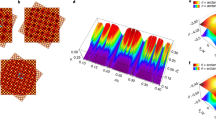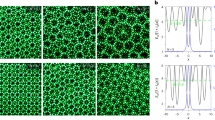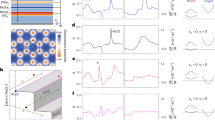Abstract
Moiré lattices consist of two superimposed identical periodic structures with a relative rotation angle. Moiré lattices have several applications in everyday life, including artistic design, the textile industry, architecture, image processing, metrology and interferometry. For scientific studies, they have been produced using coupled graphene–hexagonal boron nitride monolayers1,2, graphene–graphene layers3,4 and graphene quasicrystals on a silicon carbide surface5. The recent surge of interest in moiré lattices arises from the possibility of exploring many salient physical phenomena in such systems; examples include commensurable–incommensurable transitions and topological defects2, the emergence of insulating states owing to band flattening3,6, unconventional superconductivity4 controlled by the rotation angle7,8, the quantum Hall effect9, the realization of non-Abelian gauge potentials10 and the appearance of quasicrystals at special rotation angles11. A fundamental question that remains unexplored concerns the evolution of waves in the potentials defined by moiré lattices. Here we experimentally create two-dimensional photonic moiré lattices, which—unlike their material counterparts—have readily controllable parameters and symmetry, allowing us to explore transitions between structures with fundamentally different geometries (periodic, general aperiodic and quasicrystal). We observe localization of light in deterministic linear lattices that is based on flat-band physics6, in contrast to previous schemes based on light diffusion in optical quasicrystals12, where disorder is required13 for the onset of Anderson localization14 (that is, wave localization in random media). Using commensurable and incommensurable moiré patterns, we experimentally demonstrate the two-dimensional localization–delocalization transition of light. Moiré lattices may feature an almost arbitrary geometry that is consistent with the crystallographic symmetry groups of the sublattices, and therefore afford a powerful tool for controlling the properties of light patterns and exploring the physics of periodic–aperiodic phase transitions and two-dimensional wavepacket phenomena relevant to several areas of science, including optics, acoustics, condensed matter and atomic physics.
This is a preview of subscription content, access via your institution
Access options
Access Nature and 54 other Nature Portfolio journals
Get Nature+, our best-value online-access subscription
$29.99 / 30 days
cancel any time
Subscribe to this journal
Receive 51 print issues and online access
$199.00 per year
only $3.90 per issue
Buy this article
- Purchase on Springer Link
- Instant access to full article PDF
Prices may be subject to local taxes which are calculated during checkout




Similar content being viewed by others
Data availability
The data that support the findings of this study are available from the corresponding author upon reasonable request.
Code availability
The codes that support the findings of this study are available from the corresponding author upon reasonable request.
References
Decker, R. et al. Local electronic properties of graphene on a BN substrate via scanning tunneling microscopy. Nano Lett. 11, 2291–2295 (2011).
Woods, C. R. et al. Commensurate–incommensurate transition in graphene on hexagonal boron nitride. Nat. Phys. 10, 451–456 (2014).
Cao, Y. et al. Correlated insulator behaviour at half-filling in magic-angle graphene superlattices. Nature 556, 80–84 (2018).
Cao, Y. et al. Unconventional superconductivity in magic-angle graphene superlattices. Nature 556, 43 (2018).
Ahn, S. J. et al. Dirac electrons in a dodecagonal graphene quasicrystal. Science 361, 782–786 (2018).
MacDonald, A. H. Bilayer graphene’s wicked, twisted road. Physics 12, 12 (2019).
Bistritzer, R. & MacDonald, A. H. Moiré bands in twisted double-layer graphene. Proc. Natl Acad. Sci. USA 108, 12233–12237 (2011).
Tarnopolsky, G., Kruchkov, A. J. & Vishwanath, A. Origin of magic angles in twisted bilayer graphene. Phys. Rev. Lett. 122, 106405 (2019).
Dean, C. R. et al. Hofstadter’s butterfly and the fractal quantum Hall effect in moiré superlattices. Nature 497, 598–602 (2013).
San-Jose, P., González, J. & Guinea, F. Non-Abelian gauge potentials in graphene bilayers. Phys. Rev. Lett. 108, 216802 (2012).
Stampfli, P. A dodecagonal quasiperiodic lattice in two dimensional. Helv. Phys. Acta 59, 1260–1263 (1986).
Freedman, B. et al. Wave and defect dynamics in nonlinear photonic quasicrystals. Nature 440, 1166–1169 (2006).
Levi, L. et al. Disorder-enhanced transport in photonic quasicrystals. Science 332, 1541 (2011).
Abrahams, E., Anderson, P. W., Licciardello, D. C. & Ramakrishnan, T. V. Scaling theory of localization: absence of quantum diffusion in two dimensions. Phys. Rev. Lett. 42, 673–676 (1979).
Brandes, T. & Kettemann, S. The Anderson Transition and its Ramifications: Localization, Quantum Interference, and Interactions (Springer, 2003).
Mott, N. The mobility edge since 1967. J. Phys. C 20, 3075–3102 (1987).
Aubry, S. & André, G. Analyticity breaking and Anderson localization in incommensurate lattices. Ann. Isr. Phys. Soc. 3, 133 (1980).
Boers, D. J., Goedeke, B., Hinrichs, D. & Holthaus, M. Mobility edges in bichromatic optical lattices. Phys. Rev. A 75, 063404 (2007).
Modugno, M. Exponential localization in one-dimensional quasi-periodic optical lattices. New J. Phys. 11, 033023 (2009).
Li, C., Ye, F., Kartashov, Y. V., Konotop, V. V. & Chen, X. Localization–delocalization transition in spin–orbit-coupled Bose–Einstein condensate. Sci. Rep. 6, 31700 (2016).
Lahini, Y. et al. Observation of a localization transition in quasiperiodic photonic lattices. Phys. Rev. Lett. 103, 013901 (2009).
Roati, G. et al. Anderson localization of a non-interacting Bose–Einstein condensate. Nature 453, 895–898 (2008).
Lüschen, H. P. et al. Single-particle mobility edge in a one-dimensional quasiperiodic optical lattice. Phys. Rev. Lett. 120, 160404 (2018).
Ye, L., Cody, G., Zhou, M., Sheng, P. & Norris, A. N. Observation of bending wave localization and quasi mobility edge in two dimensions. Phys. Rev. Lett. 69, 3080–3083 (1992).
Schwartz, T., Bartal, G., Fishman, S. & Segev, M. Transport and Anderson localization in disordered two-dimensional photonic lattices. Nature 446, 52–55 (2007).
Huang, C. et al. Localization delocalization wavepacket transition in Pythagorean aperiodic potentials. Sci. Rep. 6, 32546 (2016).
Sgrignuoli, F., Wang, R., Pinheiro, F. & Dal Negro, L. Localization of scattering resonances in aperiodic Vogel spirals. Phys. Rev. B 99, 104202 (2019).
Fleischer, J., Segev, M., Efremidis, N. & Christodoulides, D. Observation of two-dimensional discrete solitons in optically induced nonlinear photonic lattices. Nature 422, 147–150 (2003).
Efremidis, N. K., Sears, S., Christodoulides, D. N., Fleischer, J. W. & Segev, M. Discrete solitons in photorefractive optically induced photonic lattices. Phys. Rev. E 66, 046602 (2002).
Franklin, P. The elementary theory of almost periodic functions of two variables. J. Math. Phys. 5, 40–54 (1926).
Suárez Morell, E., Correa, J. D., Vargas, P., Pacheco, M. & Barticevic, Z. Flat bands in slightly twisted bilayer graphene: tight-binding calculations. Phys. Rev. B 82, 121407 (2010).
Brouder, C., Panati, G., Calandra, M., Mourougane, C. & Marzar, N. Exponential localization of Wannier functions in insulators. Phys. Rev. Lett. 98, 046402 (2007).
Peleg, O. et al. Conical diffraction and gap solitons in honeycomb photonic lattices. Phys. Rev. Lett. 98, 103901 (2007).
Billy, J., Sanchez-Palencia, L., Bouyer, P. & Aspect, A. Direct observation of Anderson localization of matter waves in a controlled disorder. Nature 453, 891–894 (2008).
Acknowledgements
P.W. and F.Y. acknowledge support from the NSFC (grant numbers 91950120, 11690033 and 61475101). Y.V.K. and L.T. acknowledge support from the Severo Ochoa Excellence Programme (SEV-2015-0522), Fundacio Privada Cellex, Fundacio Privada Mir-Puig and CERCA/Generalitat de Catalunya. F.Y. thanks Z. Chen, Y. Hu and D. Song for technical discussions on the experiment with the SBN crystals.
Author information
Authors and Affiliations
Contributions
All authors contributed significantly to the study.
Corresponding author
Ethics declarations
Competing interests
The authors declare no competing interests.
Additional information
Publisher’s note Springer Nature remains neutral with regard to jurisdictional claims in published maps and institutional affiliations.
Extended data figures and tables
Extended Data Fig. 1 Evolution of light in moiré lattices.
Experimentally observed intensity distributions of the probe beam (colour-surface plots) and corresponding theoretically calculated distributions (insets) at different propagation distances z, for tanθ = 3−1/2 and p2 = 0.1 (below the LDT point; top row), tanθ = 3−1/2 and p2 = 1 (above the LDT point; middle row) and tanθ = 3/4 and p2 = 1 (bottom row). The two top rows correspond to the incommensurable Pythagorean lattice shown in Fig. 1b. The third row corresponds to the commensurable lattice shown in Fig. 1c.
Extended Data Fig. 2 Numerical simulation of light propagation to distances beyond the crystal length.
a, b, Numerical simulations of the light-beam propagation in the incommensurable moiré lattice for central excitation, corresponding to the top and middle rows of Extended Data Fig. 1, but for larger distances, exceeding the sample length. c, d, Similar numerical results, but for an off-centre excitation position in the moiré lattice. p2 = 0.1 (a, c), p2 = 1.0 (b, d), θ = π/6. In all cases, a Gaussian beam exciting a single site of the potential is assumed.
Extended Data Fig. 3 Experimental setup.
λ/2, half-wave plate; PBS, polarizing beam splitter; SF, spatial filter; L, lens; BS, beam splitter; ID, iris diaphragm; M, mirror; P, polarizer; SBN, strontium barium niobate crystal; CCD, charged-coupled device. Mask 2 is an amplitude mask used to produce two group of sub-lattices with rotation angle θ, and mask 1 is made of a polarizer film.
Supplementary information
Supplementary Information
This file contains Supplementary Information sections 1–4 and Supplementary References.
Rights and permissions
About this article
Cite this article
Wang, P., Zheng, Y., Chen, X. et al. Localization and delocalization of light in photonic moiré lattices. Nature 577, 42–46 (2020). https://doi.org/10.1038/s41586-019-1851-6
Received:
Accepted:
Published:
Issue Date:
DOI: https://doi.org/10.1038/s41586-019-1851-6
This article is cited by
-
Disorder scattering in classical flat channel transport of particles between twisted magnetic square patterns
Communications Physics (2024)
-
Observation of localization of light in linear photonic quasicrystals with diverse rotational symmetries
Nature Photonics (2024)
-
Twisted photonic Weyl meta-crystals and aperiodic Fermi arc scattering
Nature Communications (2024)
-
Two-dimensional localized modes in nonlinear systems with linear nonlocality and moiré lattices
Frontiers of Physics (2024)
-
M-shaped solitons in cubic nonlinear media with a composite linear potential
Nonlinear Dynamics (2024)
Comments
By submitting a comment you agree to abide by our Terms and Community Guidelines. If you find something abusive or that does not comply with our terms or guidelines please flag it as inappropriate.



